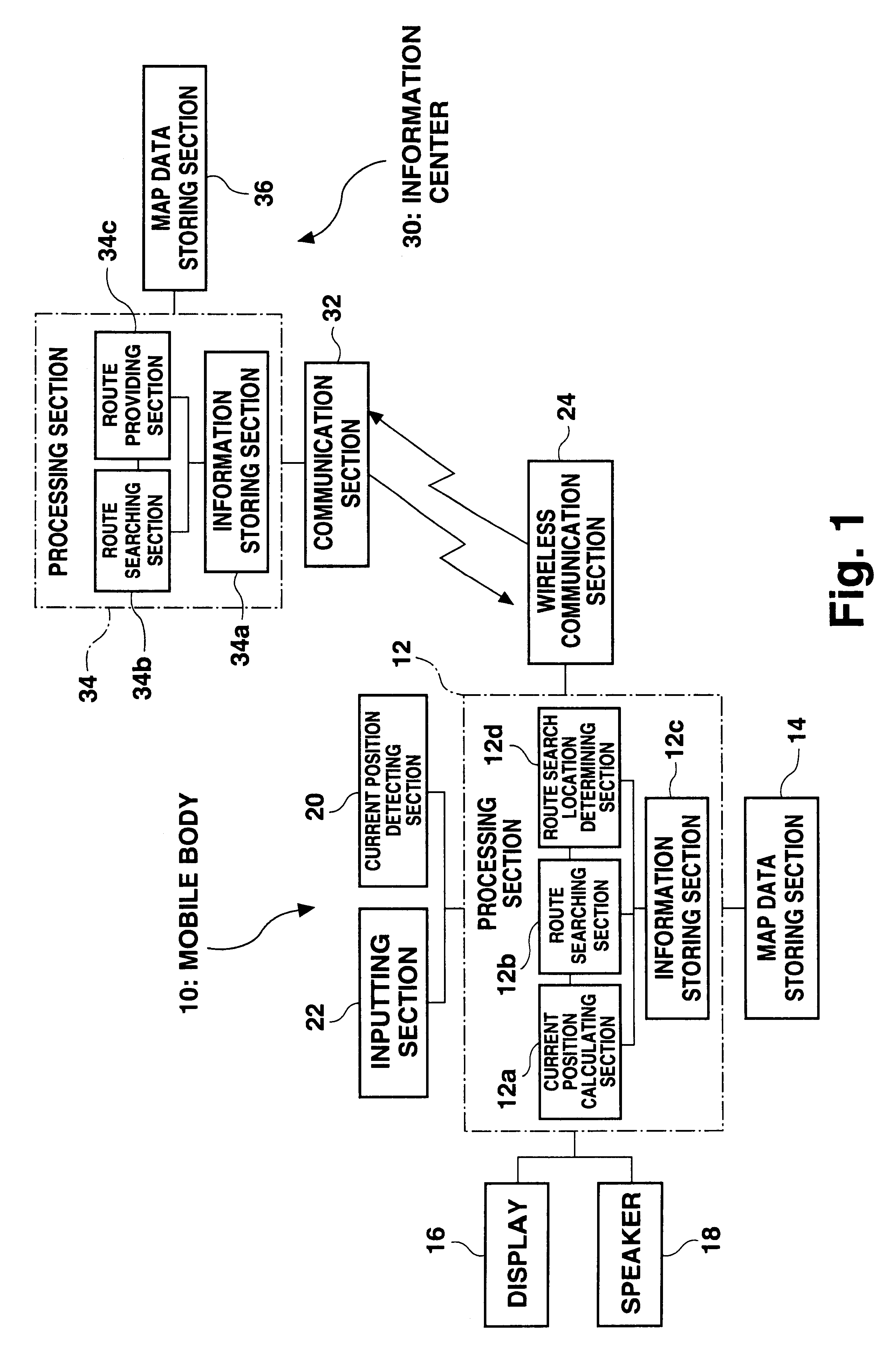Navigation device and method of use having two separate route searching devices
a navigation device and route search technology, applied in the direction of navigation instruments, direction finders using radio waves, instruments, etc., can solve the problems of requesting a route search to the information center, affecting the accuracy of the display, and requiring communication costs
- Summary
- Abstract
- Description
- Claims
- Application Information
AI Technical Summary
Benefits of technology
Problems solved by technology
Method used
Image
Examples
first embodiment
FIG. 1 is a diagram showing an overall structure of a system according to a first embodiment. A processing section 12 constructed from a computer is provided on a mobile body (vehicle) 10. A map data storing section 14 comprising storing medium such as a DVD is connected to the processing section 12. Map data is read from the map data storing section 14 and used by the processing section 12 when necessary. A display 16 such as an LCD (liquid crystal display) and a speaker 18 are connected to the processing section 12 for displaying route guidance on the display 16 and outputting a guiding voice from the speaker 18.
A current position detecting section 20 such as a GPS device is connected to the processing section 12. A current position calculating section 12a within the processing section 12 receives a signal from the current position detecting section 20, compares the signal with the map data from the map data storing section 14, and recognizes the current position of the vehicle as...
example 1-1
FIG. 2 is a flowchart showing an operation of the route search location deciding section 12d according to an example 1-1. In this example, the search location is determined based on the route type.
First, it is judged if there is a route search request from a user (step S11). When there is such a request, route type information is obtained (step S12). The route type information is information indicating a condition for route search such as whether to set higher priority to the highway, to the normal road, or to the travel time (shortest time), and whether to set higher priority to the distance (shortest distance) or to the cost (smallest travel expense). The route type is determined by, for example, a user input.
The search location is then determined based on the obtained route type (step S13). For example, information on the highway is usually correct even from the information on the mobile body, and thus, the route search for using the highway is conducted at the mobile body. For r...
example 1-2
FIG. 3 is a flowchart showing an operation of the route search location deciding section 12d in an example 1-2. In this example, when a plurality of routes are simultaneously searched, search location for each route is separately determined based on the route type.
First, it is judged whether there is a route search request from a user (step S21). Then, when there is such a request, route type information is obtained as route search information (step S22). The route type is similar to the above example, and is information such as whether to set higher priority to the highways. In this example, a plurality of searches for a plurality of route types are conducted in parallel according to, for example, the user setting. Then, route search loads for each of the search based on a plurality of route types are estimated (step S23). For example, the load for the route search can be obtained by pre-storing numbers such as 10 for priority on the highway, 20 for priority on the normal road, and...
PUM
 Login to View More
Login to View More Abstract
Description
Claims
Application Information
 Login to View More
Login to View More - R&D
- Intellectual Property
- Life Sciences
- Materials
- Tech Scout
- Unparalleled Data Quality
- Higher Quality Content
- 60% Fewer Hallucinations
Browse by: Latest US Patents, China's latest patents, Technical Efficacy Thesaurus, Application Domain, Technology Topic, Popular Technical Reports.
© 2025 PatSnap. All rights reserved.Legal|Privacy policy|Modern Slavery Act Transparency Statement|Sitemap|About US| Contact US: help@patsnap.com



